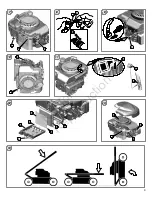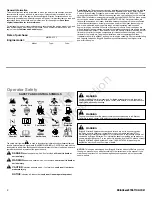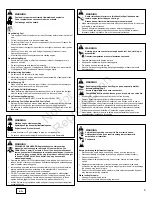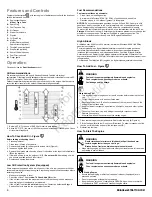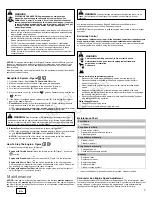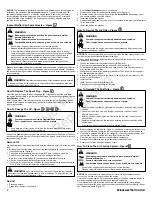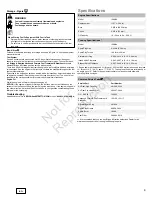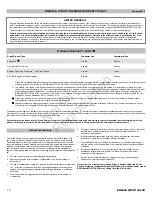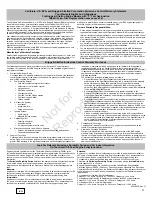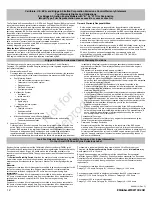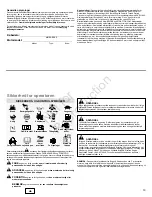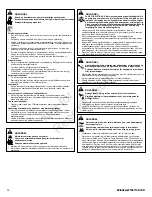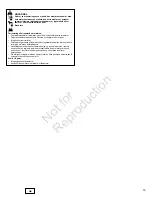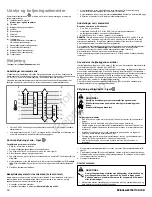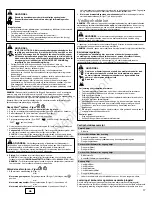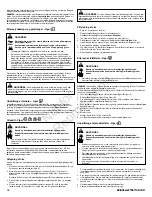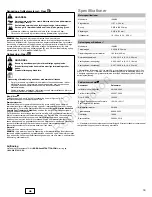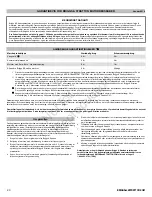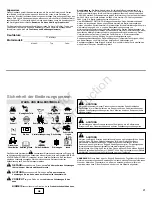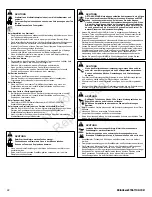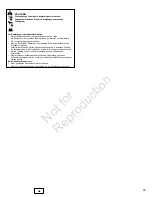
8
BRIGGSandSTRATTON.COM
NOTICE:
The equipment manufacturer specifies the maximum speed for the engine as
installed on the equipment.
Do not exceed
this speed. If you are unsure what the
equipment maximum speed is, or what the engine speed is set to from the factory,
contact a Briggs & Stratton Authorized Service Center for assistance. For safe and
proper operation of the equipment, the engine speed should be adjusted only by a
qualified service technician.
Inspect Muffler And Spark Arrester -
Figure
1
Running engines produce heat. Engine parts, especially muffler,
become extremely hot.
Severe thermal burns can occur on contact.
Combustible debris, such as leaves, grass, brush, etc. can catch fire.
WARNING
Allow muffler, engine cylinder and fins to cool before touching.
Remove accumulated debris from muffler area and cylinder area.
It is a violation of California Public Resource Code, Section 4442, to use or
operate the engine on any forest-covered, brush-covered, or grass-covered land
unless the exhaust system is equipped with a spark arrester, as defined in
Section 4442, maintained in effective working order. Other states or federal
jurisdictions may have similar laws. Contact the original equipment
manufacturer, retailer, or dealer to obtain a spark arrester designed for the
exhaust system installed on this engine.
Remove accumulated debris from muffler area and cylinder area. Inspect the muffler (
H
,
Figure 1) for cracks, corrosion, or other damage. Remove the spark arrester, if equipped,
and inspect for damage or carbon blockage. If damage is found, install replacement parts
before operating.
WARNING:
Replacement parts must be of the same design and installed
in the same position as the original parts. Other parts may not perform as well, may
damage the unit, and may result in injury.
How To Replace The Spark Plug -
Figure
8
Check the gap (
A
, Figure 8) with a wire gauge (
B
). If necessary, reset the gap. Install
and tighten the spark plug to the recommended torque. For gap setting or torque, see the
Specifications
section.
Note:
In some areas, local law requires using a resistor spark plug to suppress ignition
signals. If this engine was originally equipped with a resistor spark plug, use the same
type for replacement.
How To Change The Oil -
Figure
1
9
10 11
WARNING
Fuel and its vapors are extremely flammable and explosive.
Fire or explosion can cause severe burns or death.
If you drain the oil from the top oil fill tube, the fuel tank must be empty or fuel
can leak out and result in a fire or explosion.
Used oil is a hazardous waste product and must be disposed of properly. Do not discard
with household waste. Check with your local authorities, service center, or dealer for safe
disposal/recycling facilities.
Remove Oil
You can drain the oil from the bottom drain hole, the side drain hole, or from the top oil fill
tube.
1. With engine off but still warm, disconnect the spark plug wire (
A
) and keep it away
from the spark plug (Figure 9).
2. The engine is equipped with a bottom drain (
G,
Figure 1) and/or a side drain
.
Remove the oil drain plug. Drain the oil into an approved container.
Note:
Any of the oil drain plugs (
G
) shown may be installed in the engine.
3. After the oil has drained, install and tighten the oil drain plug.
4. If you drain the oil from the top oil fill tube (
E
), keep the spark plug end of the engine
(
F
) up (Figure 10). Drain the oil into an approved container.
WARNING:
If you drain the oil from the top oil fill tube, the fuel tank must
be empty or fuel can leak out and result in a fire or explosion. To empty the fuel tank,
run the engine until it stops from lack of fuel.
Add Oil
Place engine level.
Clean the oil fill area of any debris.
See the
Specifications
section for oil capacity.
1. Remove the dipstick (
G
) and wipe with a clean cloth (Figure 11).
2. Pour the oil slowly into the engine oil fill (
H
).
Do not overfill.
After adding oil, wait
one minute and then check the oil level.
3. Install and tighten the dipstick.
4. Remove the dipstick and check the oil level. It should be at the top of the full indicator
(
J
) on the dipstick.
5. Install and tighten the dipstick.
How To Service The Air Filter -
Figure
12
WARNING
Fuel and its vapors are extremely flammable and explosive.
Fire or explosion can cause severe burns or death.
Never start or run the engine with the air cleaner assembly (if equipped) or the
air filter (if equipped) removed.
NOTICE:
Do not use pressurized air or solvents to clean the filter. Pressurized air can
damage the filter and solvents will dissolve the filter.
The air cleaner system uses a pleated filter with an optional pre-cleaner. The pre-cleaner
can be washed and reused.
1. Loosen the fastener (
A
) that holds the cover (
B,
Figure 12).
2. Open the cover and remove the pre-cleaner (
C
) and the filter (
D
).
3. To loosen debris, gently tap the filter on a hard surface. If the filter is excessively
dirty, replace with a new filter.
4. Wash the pre-cleaner in liquid detergent and water. Then allow it to thoroughly air
dry.
Do not
oil the pre-cleaner.
5. Assemble the dry pre-cleaner to the filter with the lip (
E
) of the pre-cleaner on the
bottom of the filter pleats.
6. Install the filter.
7. Install the cover tabs (
F
) into the slots (
G
).
8. Close the cover and secure with the fastener.
How To Replace The Fuel Filter -
Figure
6
WARNING
Fuel and its vapors are extremely flammable and explosive.
Fire or explosion can cause severe burns or death.
Keep fuel away from sparks, open flames, pilot lights, heat, and other ignition
sources.
Check fuel lines, tank, cap, and fittings frequently for cracks or leaks.
Replace if necessary.
Before cleaning or replacing the fuel filter, drain the fuel tank or close the fuel
shut-off valve.
Replacement parts must be the same and installed in the same position as the
original parts.
If fuel spills, wait until it evaporates before starting engine.
1. Before replacing the fuel filter (
A,
Figure 6), if equipped, drain the fuel tank or close
the fuel shut-off valve. Otherwise, fuel can leak out and cause a fire or explosion.
2. Use pliers to squeeze tabs (
B
) on the clamps (
C
), then slide the clamps away from
the fuel filter. Twist and pull the fuel lines (
D
) off of the fuel filter.
3. Check the fuel lines for cracks or leaks. Replace if necessary.
4. Replace the fuel filter with an original equipment replacement filter.
5. Secure the fuel lines with the clamps as shown.
How To Clean The Air Cooling System -
Figure
13
Running engines produce heat. Engine parts, especially muffler,
become extremely hot.
Severe thermal burns can occur on contact.
Combustible debris, such as leaves, grass, brush, etc. can catch fire.
WARNING
Allow muffler, engine cylinder and fins to cool before touching.
Remove accumulated debris from muffler area and cylinder area.
NOTICE:
Do not use water to clean the engine. Water could contaminate the fuel
system. Use a brush or dry cloth to clean the engine.
This is an air cooled engine. Dirt or debris can restrict air flow and cause the engine to
overheat, resulting in poor performance and reduced engine life.
Use a brush or dry cloth to remove debris from the finger guard (
A
). Keep linkage,
springs and controls (
B
) clean. Keep the area around and behind the muffler (
C
) free of
any combustible debris (Figure 13).
Not for
Reproduction



